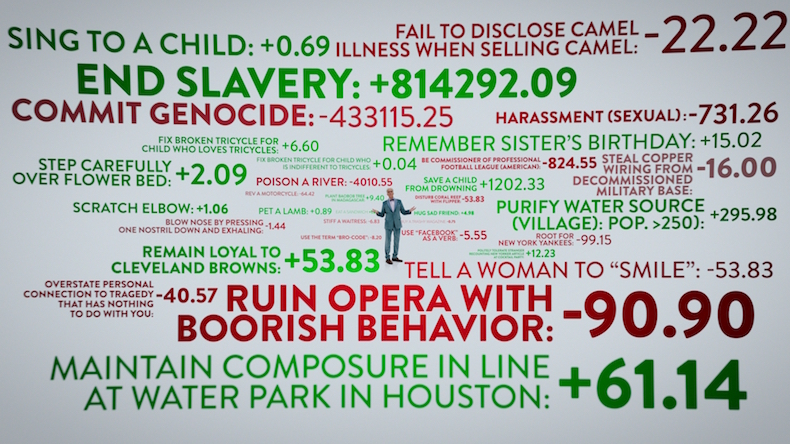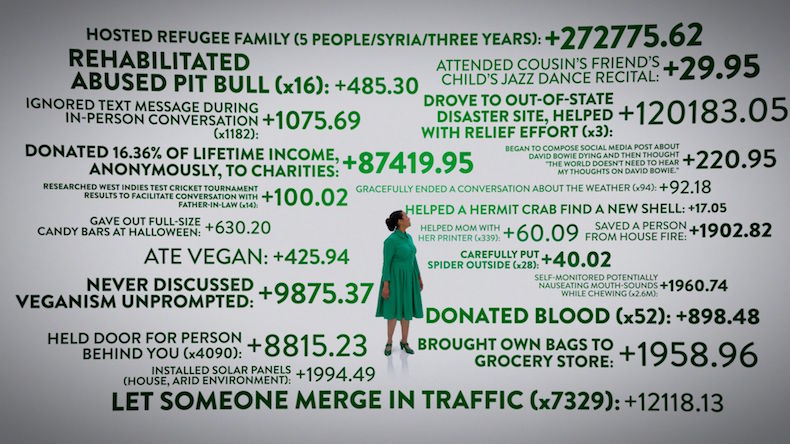I have written before about my enjoyment of the excellent TV comedy The Good Place and gave it a rave review. One of the things I noticed is that there are many hidden jokes that either fly by very fast or that are on the periphery of your vision. Some of those involve the complicated points system for every single action and whose final total at death is used to determine whether you are a good person, deserving to go to the Good Place or a bad person who needs to go to the Bad Place. Samples of the point system flash by on a screen too fast to see more than one or two. You have to freeze the frame to read them all and this website has grabbed a couple of them.
In the second season, they have a simulation of the famous (or should I say infamous) ‘Trolley Problem’ and I noticed the trolley racing past a movie theater and obscuring the marquee. Suspecting that I was missing something, I went back and froze the scene and saw that the films that were showing in the cinema were called Strangers Under the Train and Bend it Like Bentham, which gave me a good laugh, since Jeremy Bentham is the founder of the school of philosophy known as utilitarianism that is put to the test in the trolley problem.
But I began to wonder about the purpose of such hidden jokes. Why insert them so briefly or subtly that most people will miss them? I took the trouble to go back and find those scenes and freeze them so that I could read everything. I suspect that most people will either not notice them at all or even if they suspect they missed something, won’t be bothered to go back
Maybe the writers just had fun during brainstorming sessions coming up with these jokes but did not have room to give them too much prominence and left them in that form as bonus humor for those interested enough.



The term of art is “Easter eggs”, and they have appeared in art, video games, and film for a long time before “The Good Place”.
The population of the sort of person who will go over a video frame-by-frame looking for easter eggs is non-zero, and overlaps the population of people involved with video production.
It’s partly for the benefit of the people who trawl for such things. But I think it also just amuses the people involved in production. While the jokes proper are sufficient when viewing, I don’t suppose they land on a daily basis for the set designers or graphical effects artists or editors, but these little details do.
The studio is doing a fun podcast, too, hosted by actor Marc Evan “Shawn” Jackson, where they interview the actors, writers, designers, and producers. There’s one episode per (previous) show episode, where he summarizes the plot, then talks to people who worked on the episode. There are currently 2 podcasts per week, as they are trying to catch up to the end of season 2 before season 3 starts in September.
Who on earth is the top guy? He apparently ended slavery and committed genocide, all while living in the modern era.
Also, “Blow nose by pressing one nostril down and exhaling” times thousands, at -1.44 a pop… I’m in a world of trouble.
Holes @#4,
All those points are not for a single person. They are general points for anyone who does that specific thing. The man in the top image is Michael (played by Ted Danson), the architect of The Good Place and this slide is part of his presentation to the people who have just arrived there about how the system works.
@4 Holms That’s Michael, the designer of this particular heavenly neighbourhood. Those are just examples he’s giving as he explains the points system during afterlife orientation.
Only a point and a half for rescuing spiders? So much for my plans. Wait, what about snakes? I’ve rescued quite a few snakes trapped indoors.
What about TRYING to donate blood and constantly being rejected due to allergies that COULD be colds?
Wait, my salvation! I do carefully monitor my mouth sounds when chewing! Thanks, Dad, for making me paranoid about that! I might get in the good place yet!
The first time I remember seeing something like this was in the BBC’s cheap but wonderful television adaptation of The Hitchhikers Guide to the Galaxy. Faced with having to do something with the Guide entries, which had been designed as expository dumps for a radio audience who couldn’t see what was going on, they had the fantastic idea of illustrating them in a computery style (with hand animation). They had the even more brilliant idea of making the animations go by too fast to actually read. This was in an era when few people had video tape machines. It was a deliberate attempt by Adams to give the audience more than they could process in real time. He said
“I like the idea of a programme where, when you get to the end of it, you fell you didn’t get it all. There are so many programmes that are half an hour long and at the end of it you’re half an hour further into your life with nothing to show for it. If you didn’t get it all, that’s much more stimulating” -- quote from “Don’t Panic”, by Neil Gaiman.
Dang it, Mano. Now I want the next season to be here already. This show is amazing and just two seasons in it should be in the discussion as one of the all time greats. Though maybe that “just two seasons in” is unfair, because Fawlty Towers gets to be in that discussion too and its entire two series run had fewer episodes that just a single season of an American show.
I’m also of the belief that just because I love a show doesn’t mean it should keep churning out episodes. One of the reasons Fawlty Towers is so fondly remembered is that it made the episodes it did and didn’t leave people talking about when it was good. While I’m happy NBC saved Brooklyn Nine-Nine I’m worried it may have already seen its best days. With The Good Place I’ll be fine if this season or next is the last.
Tabby,
I agree that TV shows tend to run on far too long even after the concept has worn thin and they have run out of new ideas.
British TV series are much better at self-control. Many of them are at most a half-dozen episodes each season. This gives the writers more time to produce good scripts for the next season. Even then, it is unusual to have even as many as three seasons.
The Good Place was unusual for US commercial TV in that each season was only about a dozen episodes, while the usual number is 22. Galavant also had a total of just 18 episodes in two seasons and although I was sorry to see it end, I thought it was good that it did.
Yes! Even then, the second season annoyed me the way they sidelined Isabella which would have made a third season very worrisome.
I’ve been listening to the podcast mentioned @#3 above (main site, RSS feed for the episodes), and the one I’ve been currently listening to touches on exactly the point of hidden jokes.
MP3 link: Ch. 5: Kristen Bell, Actress | Morgan Sackett, Executive Producer
KB=Kristen Bell
MS=Morgan Sackett, Executive Producer
MEJ=Marc Evan Jackson (the host), who plays Shawn
[They are discussing the details of the show, and how they hired philosophy professors to inform the writers and actors, and the papers that the characters were supposed to have written were handed to them by the props department, and had real text meant to be in the style of the characters writing]
about 23:30 in:
MS: …so we’d done that with other things, so we found, not as many of these people, but we’d find 3 or 4, and then a lot of books.
MEJ: Because the Internet will come for you, right? You can’t just put out a Wikipedia cursory thing -- the universe wants to know that you understand it.
MS: It’s so different now -- Chidi’s board had to have the proper stuff. Now everybody pauses everything, and reads everything. I think our props people on Parks [& Recreation] used to do this, where they’d write up every document, but now you have to, because people will pause it, and read the document. And they love it if you put more, if you put jokes in those things.
MEJ: Oh, for sure.
MEJ: Early on, I myself froze it, ’cause as you said, the show didn’t air until we were done shooting. So when it was points totals, what was plus and minus points? I definitely zoomed in.
MS: That, we changed up until the day before we aired. We kept changing out point totals, and what would get plusses and minuses.
KB: In the yogurt shop, when you order, and you’re able to see all 400 different types of yogurts, and some are like: “A nap”. “Full cell phone charge”. “Folded laundry”. It’s amazing; I remember taking pictures of it on my phone. Just to remember all of the good things.
MS: And then we extended it. David Niednagel [Visual Effects Supervisor] extended it.
MEJ: So some of that’s practical, and actually on the wall?
MS: There were probably 100 and some on the wall, and then there were, I dunno, 500 we visual effected it down, and wrote all of the other ones.
MEJ: This is the strangest show on television. I love it so much.
[Doing transcripts of natural dialogue is hard. I left out crosstalk, and tried to put in the sense of what they were saying, for the most part. I hope I didn’t garble things too much]
Owlmirror @#13,
Thanks for the transcript. I liked it so much that I listened to the podcast and it was fun.